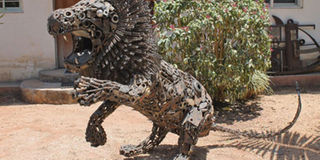Local artist collective continues to inspire

Welders bring metal to life with pieces such as this lion.
What you need to know:
She is part of a team at Wonder Workshop that recycles scrap metal to forge pieces ranging from a life-size lion to a miniature giraffe. The organization brands itself as creating “hip recycled
art.”
Diama Shadrack Milwapa is one of the few women in her trade. The 32-year-old welder works at a local artistic collective that turns wasted materials into unique creations.
She is part of a team at Wonder Workshop that recycles scrap metal to forge pieces ranging from a life-size lion to a miniature giraffe. The organization brands itself as creating “hip recycled
art.”
“If I was doing something else, I wouldn’t be as happy,” Milwapa says through a translator.
Wonder Workshop, which mainly employs physically disabled artists, has seen its popularity
slowly increase since it launched more than a decade ago.
Milwapa stands apart as a pioneer. She works in an industry dominated by men and is the only
female welder at Wonder Workshop.
“I’m very happy working,” she says. “It’s a strictly work environment and the men respect me.”
Milwapa says that she studied welding in school before working at a train station in Dar es Salaam, where she was one of two female welders.
“There were so many men and all the teachers were men,” she says.
But Milwapa adds that she has become apart of the team wherever she has worked.
“They took me in as a sister, I blended in,” she says.
She began working at Wonder Workshop eight years ago in the glass section, creating jewelry
out of recycled glass beads.
“When I found out there was welding, I was excited because I could use the skills I learned,” she
says, adding that she was able to move into welding three years ago.
“Here, it’s more artistic, but the skills I use are the same as at the train station.”
Milwapa says even though it’s a dangerous job that can result in burns or other injuries, she chose welding because she loves it.
She adds that with her savings she eventually hopes to open her own workshop one day.
"I don't have the money for whole costs, so I'll keep working. If the chance comes one day, I'll go for it."
Timothy Johnston, general manager at Wonder Workshop, says the organization employs women in its other artistic sections to create glass jewelry, paper, and soap from recycled materials.
Originally Wonder Workshop employed only men because it focused exclusively on welding, he adds.
“I don’t know many (women) who can do welding. Not because of nature, but nurture.”
“I think originally it was first only men, but by expanding to five sections, that’s where we created jobs for women.”
Asha Alfeine sits with a group of women cutting pineapple leaves to eventually produce sun-dried paper. The paper is used to make notebooks, picture frames and greeting cards.
She says she primarily creates soap but helps out in the paper section as well.
“I wouldn't mind working in any section,” she says through a translator, adding that less women end up in woodwork and welding.
Neema Mohamed, who works in the glass section, says she has a chance to be creative with her work.
“I'd love to learn more trades, arts,” she says through a translator. “I want to improve my skills and knowledge.”
Johnston adds that of 30 employees, 24 of them have physical disabilities, such as those caused by polio.
He says the fact the organization has been open for 10 years shows its success.
“That speaks for itself,” he says. “There have been many ups and downs … because we don’t get any outside funding.
“It’s sustainable.”
The organization receives occasional donations but there isn’t any regular funding to depend on.
Johnston says that he believes in the quality of the artwork.
“I wouldn’t be happy with my job if people were buying things and thinking that they are ugly,” he says, adding that he is currently trying to get a better idea of what pieces are most popular.
“What makes a difference is we are very, very well-known.”
Past international visitors to Wonder Workshop include Prince Charles, U.S. President George W. Bush and Prince Fumihito of Japan.
The work of the organization can also be seen around Dar es Salaam – large commissioned pieces can be seen at The Slow Leopard and George and Dragon pubs, Karambezi Café, and at
roundabouts in the city centre.
“The dragon we just built for the heck of it, and … I approached George and Dragon and they liked it,” Johnston says. “With bigger pieces, there is big visibility, bigger revenue.”
He adds that the organization struggles to have a steady stream of revenue over the course of a year.
“I could sleep better at night if there was a foundation that would give us a regular donation.”
Last week, the organization held a fair, drawing in crowds while showcasing art. Johnston says
Wonder Workshop continues to gain popularity, creating art that can be found nowhere else.
“Everyone should come here,” he says with a laugh.




